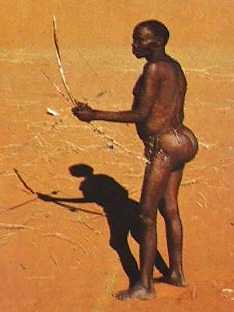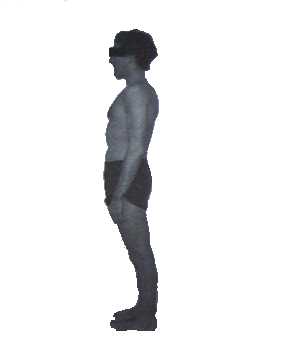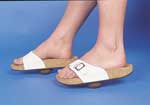Totally different body shapes...
The Rounded Buttock of the Bushman...
|
 |
The "Flat-assed" Westerner...
|
 |
Each man approximates the ideals of beauty and fitness
within the context of his own society.
Who is to say which one is right?
|
Steatopygia a Racial Characteristic of the Bushman
(email from JS - )
Steatopygia Definition: (from the Greek for "fatty rump"), Steatopygia is an unusual accumulation
of fat in and around the buttocks... This curious development constitutes a racial characteristic of the Bushmen...
Steatopygia would seem to have been a characteristic of a race which once extended
from the Gulf of Aden to the Cape of Good Hope, of which stock Bushmen and Pygmies are remnants.
(excerpted from
Wikipedia
- see also reference 23).
Dear Bruce,
I found your site recently and quite enjoyed it. Your thoughts about
being barefoot causing a positive alteration in walking mechanics are
very close to my own. There is much on your site that will help
people who have not been helped by orthotics, physical therapy, etc.
However, I'd like to point out some information regarding the hindest
parts of the Bushmen that might otherwise come at you from a less
sympathetic source. It appears that much of the enlargement of the
buttocks seen in these people is stored excess fatty tissue, a result
of long-term sexual selection for such traits. This is termed
steatopygia in biological anthropology circles. A short description
of this term can be found here:
http://www.reference.com/browse/wiki/Steatopygia. I live in China,
where Wikipedia has recently been banned. However, I suggest a search
on wikipedia.org for steatopygia, as that site is usually fruitful.
These things being said, in analysing film of Bushmen walking and
running I must agree that there is a different quality, a certain
"glutealness" to it. I know precisely what you mean when you suggest
walking barefoot on rough ground and the sensation of increased or
prolonged gluteal activation that accompanies it. I think you are on
the right track. But the massive buttocks seen in the Bushmen male on
your "Engage..." page is likely a case of mild steatopygia.
Yours,
JS
P.S. Vladamir Janda's Balance Sandals
Are you familiar with
Vladamir Janda's work? If so, you might be interested in finding or
building a pair of his balance sandals (see Google). He claimed that
5 minutes or so a day walking on the things promoted a long lasting
improvement in gluteal facilitation at heel strike - something like
50%, if I recall correctly.
Editors notes: (1) Good film footage of Bushman walking and running is to be found in
the movies "The Gods must be Crazy" and "The Gods must be Crazy II".
Look for them at your video rental store, or purchase them (advert top right of page). - They are very funny, and very informative.
(2) Check out Reference 24 for
more dicussion on Janda balance sandals.
|
Diagram: The Janda Balance Sandal

|
Return to Top
Gluteal Development in the Southern African Tribes, Social & Clinical Comments
Comment kindly provided by South African physiotherapist
Gustav Thalwitzer...
Hi Bruce!
Just a couple of observations from your e-mail and my own past experience.
You are very astute in your observations regarding the Bushmen and their way
of walking and squatting. However, this phenomenon is not exclusive to them.
It can be observed among most of the related tribes, such as the
Nama,(Khoisan), Damara and Hottentot tribal people.
A point of pride...
As a point of interest,
this is a mattter of pride in some of the tribes, and a maid or young man
with exceptional gluteal development is highly sought after.
Hip and lower back problems are almost unheard of...
Another
interesting fact is that hip and lower back problems are almost unheard of
in the tribes mentioned above. As you point out in your article, their
characteristic forward stance and squat is vastly different from what would
be considered normal and/or acceptable in western society. Although I have
never considered the specifics of gluteal development in this regard, it
makes valid sense from a physical viewpoint. The lower back is not really
designed to point to the sky like an aerial, and our western posturising can
sometimes lead to more problems than the social acceptance of such
justifies. Although hip replacements are becoming more common in SA, I have encountered
very few cases of this in the indigenous tribes.
Poorly developed calf muscles...
The indigenous tribes rely on their legs and
feet as the main means of transportation in most of the rural areas in
Africa. As a result, most of them have fairly well developed upper legs, but
it is not common to see them with well developed calf muscles, another area
where western and african viewpoints of what is desirable and admirable in
the humen body differ. It is not uncommon for very old people in the rural
areas to still walk vast distances daily. And the first thing that you would
probably observe are the thin legs and big buttocks most seem to posses.
Just another racial characteristic, or is it because they actually use their
muscles more in the way it was designed to be used? Makes one wonder.
Another point to ponder is the prevalence of lower back problems in military
and ex-military personnel. Related to the "military" stance??
20 miles a day on bare feet!...
You mention the effect of barefeet walking and running, and quote Zola Budd
in this regards. Bear in mind that a Bushman may walk as much as 20 miles a
day on a hunting trip, and even the women would probably cover as much as 10
to 15 miles gathering food, all this on bare feet. I have grown up on a
farm with Bushmen and I found your article on the Bushmen(San) fascinating.
Well done!
Obervations of Hip joint replacement surgery...
The [hip replacement] operations I observed were on an older lady with almost flat buttocks,
even though she was otherwise fairly overweight, and a gentleman who was
quite thin. It does seem to tie in with your observation. Another strange
observation I have made is that most of the people I have treated with lower
back problems do not seem to be really overweight, and that few of the
so-called "bad postured" people seem to have bad back problems. Yet, if you
observe the latter, there is a definite resemblance in their stance to that
of the Bushman, and back problems are almost unheard of in Bushmen. I wish I
could say the same about certain other "western" problems they do seem to be
prone to, such as alcoholism.
Femoral neck and pelvic fractures do seem somehow connected to glute strength...
Sorry for a bit of a long-winded answer, but yes, I have to agree with
Brian's observation that [femoral neck and pelvic fractures] do seem somehow connected to glute strength.
To what extent this is true, I can but wonder, but it gives meaning to a
couple of casual observations I have made during my experience in the
treatment of patients. I think that the underdevelopment of gluteal
musculature contributes toward poor circulation in the hip and lower back,
which in turn weakens bone density and as such strength in the bone tissue.
A set of strong muscles in the area would prevent this from happening, ergo,
less chance of hip displacement, etc. I have always been a firm believer in
the more natural forms of exercise, such as walking and swimming, and your
observations have just reseated that belief firmly.
Regards,
Gus
(Gustav Thalwitzer)

Return to top...
Engage Gluteus maximus © Bruce Thomson, EasyVigour Project

|
|
|